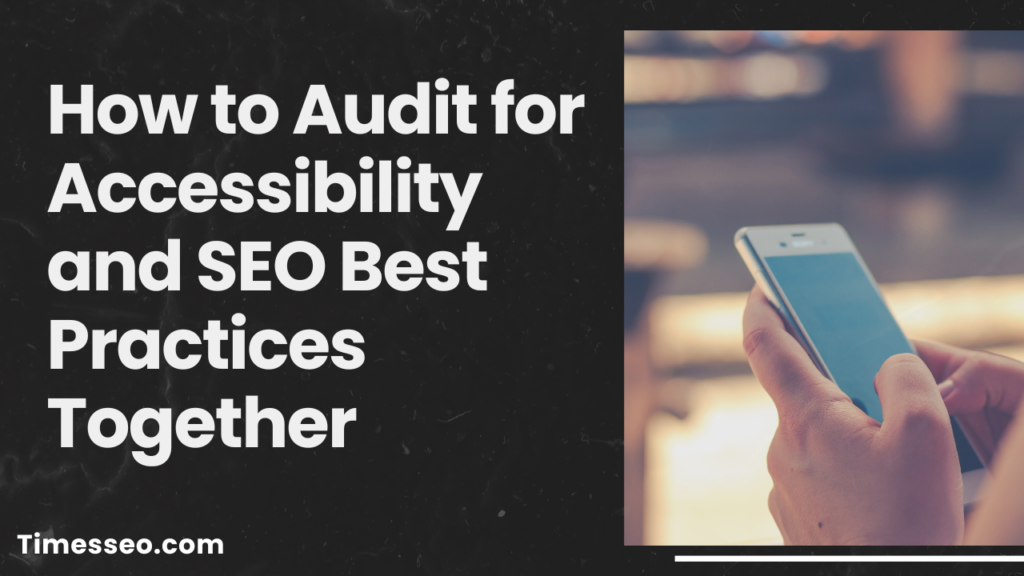
How to Audit for Accessibility and SEO Best Practices Together
Discover how to streamline your website audit by combining accessibility and SEO best practices into a single, effective process. This blog post breaks down actionable steps to ensure your WordPress site not only ranks higher on search engines but also remains inclusive and user-friendly for all visitors. From WCAG compliance to on-page SEO, learn how to optimize every element the smart way.
Table of Contents
Introduction
Why Combine Accessibility and SEO in One Audit?
Ever feel like you’re running two separate races—one for SEO and another for accessibility? Good news: you don’t have to. Many of the best practices in both areas actually align. By combining your efforts into one audit, you can save time, increase efficiency, and improve your site for both users and search engines.
The Value of a Unified Approach
Rather than running parallel audits, why not merge them? It’s more efficient, reveals shared opportunities for improvement, and provides a smoother workflow for your team. It’s like upgrading your car’s engine and fuel system at the same time—better performance all around.
Understanding the Basics
What Is Website Accessibility?
Everyone can use and comprehend your website, regardless of their impairment, thanks to website accessibility. It includes features like alt text, keyboard navigation, screen reader compatibility, and readable fonts.
What Are SEO Best Practices?
The main goal of SEO (Search Engine Optimization) is to make your website more visible to search engines. This includes improving content, speed, meta tags, mobile usability, and structured data.
Key Overlaps Between the Two
- Clear navigation benefits both users and crawlers
- Descriptive alt text helps visually impaired users and boosts image SEO
- Fast-loading pages support UX and Google rankings
- Semantic HTML supports accessibility and indexing
Pre-Audit Preparation
Define Your Audit Goals
Are you launching a new site? Trying to boost rankings? Or meeting legal accessibility requirements? To determine the audit’s scope, explicitly define your goals.
Assemble the Right Tools
You will need to have both accessibility and SEO technologies in your toolbox.
Accessibility & SEO Audit Tools
- Accessibility: WAVE, Axe, Lighthouse, NVDA
- SEO: Ahrefs, SEMrush, Screaming Frog, Google Search Console
- Multi-purpose: Chrome DevTools, Sitebulb, SEOptimer
Accessibility & SEO Plugin Recommendations
Top WordPress Tools That Handle Both
- Yoast SEO: Enhances readability, schema, and meta tags
- WP Accessibility – Adds skip links, highlights focus, and more
- One Click Accessibility – Simple enhancements for accessibility
- Rank Math: SEO tools with excellent user interface and schema support
Step-by-Step Audit Framework
1. Test for Mobile-Friendliness
Nearly 60% of web traffic is mobile. A responsive design isn’t optional—it’s essential.
Why It Matters for Accessibility and SEO
Google uses mobile-first indexing, and many accessibility challenges (like small tap targets) are worse on mobile. Test using Google’s Mobile-Friendly Test.
2. Analyze Site Structure and Navigation
Menus, internal links, and breadcrumb trails all contribute to findability and usability.
Menus, Breadcrumbs, and Internal Links
Ensure they are:
- Consistent
- Easily navigable by screen readers
- Logical and keyword-friendly
3. Review Page Load Speed
Speed is a big deal. Visitors bounce from slow sites—and so does Google.
Accessibility and Core Web Vitals
LCP, FID, and CLS are Core Web Vitals that affect experience and performance. Reduce server response time, employ caching, and compress images.
4. Examine Headings and Semantic HTML
Headings aren’t just for style—they guide screen readers and crawlers.
Heading Hierarchies and Screen Readers
There should be one H1 on each page, followed by structured H2–H4s. Avoid skipping levels or using them for styling only.
5. Evaluate Alt Text and Media Content
Every image should tell a story—even if the user can’t see it.
Optimizing Images for All Users and Bots
Alt text should:
- Describe the image
- Be concise
- Include keywords (only when natural)
Include captions and transcripts for video/audio content too.
6. Check Keyboard Navigation and Focus States
Users who can’t use a mouse still need to move around your site.
Usability Without a Mouse
- Use visible focus indicators
- Logical tab order
- Include skip links at the top of the page
7. Inspect Content Readability
Readable content = better engagement + better SEO.
Plain Language, CTA Clarity, and Font Size
Use:
- Short paragraphs
- Bullet points
- Clear CTAs
- 16px+ font size
- High contrast text/background
8. Audit Meta Tags and Structured Data
Search engines use metadata to understand your site. Make it count.
Schema Markup That Enhances Accessibility
Use structured data for:
- Products
- FAQs
- Articles
This improves visibility in SERPs and clarifies information for screen readers.
Testing Forms and Interactive Elements
Proper Labeling and Error Messaging
All form fields must have <label> tags and clear error messages. Use placeholder text sparingly.
ARIA Roles and Validation Feedback
ARIA attributes improve accessibility but must be implemented correctly. Avoid overuse, and test with screen readers.
Common Issues Found During Audits
Overlooked Accessibility Flaws
- Missing alt text
- Inaccessible forms
- Low contrast colors
- Lack of ARIA labeling
SEO Red Flags That Impact UX
- Duplicate meta tags
- Broken internal links
- Thin content
- Keyword stuffing
Fixing What You Find
Prioritizing Based on Impact
Focus on:
- Legal requirements first
- Ranking factors next
- Minor issues last
Collaborating with Devs, Designers, and Writers
Accessibility and SEO are team sports. Include everyone in the audit feedback process.
Ongoing Maintenance After the Audit
Set a Schedule for Regular Audits
Quarterly audits help catch issues before they become big problems.
Keep Up with SEO and Accessibility Trends
Follow Google Search Central, WebAIM, and industry blogs to stay updated.
Conclusion
Auditing your website for both accessibility and SEO is more than just a checkbox exercise — it’s a smart, future-focused strategy. By combining these two powerful disciplines, you create a site that’s discoverable, usable, inclusive, and competitive. Everyone wins — your visitors, your rankings, and your reputation.
Frequently Asked Questions
At least once every quarter. More often if you're making major changes or adding new content.
No. In fact, many accessibility improvements boost SEO—like using semantic HTML, alt text, and faster loading speeds.
Use tools like Lighthouse or Sitebulb that highlight both SEO and accessibility issues in one scan.
You can start solo with tools, but for deep audits, consider hiring professionals with SEO and accessibility expertise.
In many countries—yes. Accessibility lawsuits are increasing, so compliance is both smart and safe.
Table of Contents
Popular Posts
-
 Affordable Technical SEO Audit for Small Business: A Complete Guide26 Jun 2025 Blog
Affordable Technical SEO Audit for Small Business: A Complete Guide26 Jun 2025 Blog -
 How to Get an Affordable Technical SEO Audit for Small Business27 Jun 2025 Blog
How to Get an Affordable Technical SEO Audit for Small Business27 Jun 2025 Blog -
 The Ultimate Local SEO Audit Checklist for Startups28 Jun 2025 Blog
The Ultimate Local SEO Audit Checklist for Startups28 Jun 2025 Blog -
 Local SEO Audit Checklist for Startups: A Beginner’s Guide28 Jun 2025 Blog
Local SEO Audit Checklist for Startups: A Beginner’s Guide28 Jun 2025 Blog -
 Top On-Page SEO Audit Steps for Service Websites Every Business Should Know29 Jun 2025 Blog
Top On-Page SEO Audit Steps for Service Websites Every Business Should Know29 Jun 2025 Blog -
 Technical SEO for WordPress: The Ultimate Beginner’s Guide01 Jul 2025 Blog
Technical SEO for WordPress: The Ultimate Beginner’s Guide01 Jul 2025 Blog -
 The Impact of On-Page SEO Audit Steps for Service Websites on UX01 Jul 2025 Blog
The Impact of On-Page SEO Audit Steps for Service Websites on UX01 Jul 2025 Blog -
 Technical Mobile SEO Audit Tips for Developers02 Jul 2025 Blog
Technical Mobile SEO Audit Tips for Developers02 Jul 2025 Blog -
 Complete SEO Backlink Audit Guide for Better Google Rankings03 Jul 2025 Blog
Complete SEO Backlink Audit Guide for Better Google Rankings03 Jul 2025 Blog -
 Boost Your Rankings with Technical SEO for WordPress01 Jul 2025 Blog
Boost Your Rankings with Technical SEO for WordPress01 Jul 2025 Blog






